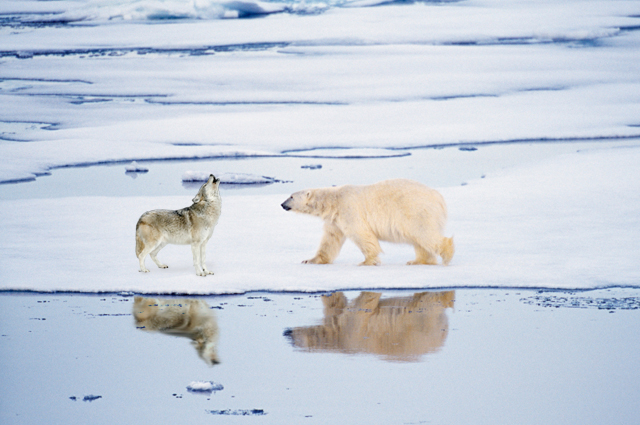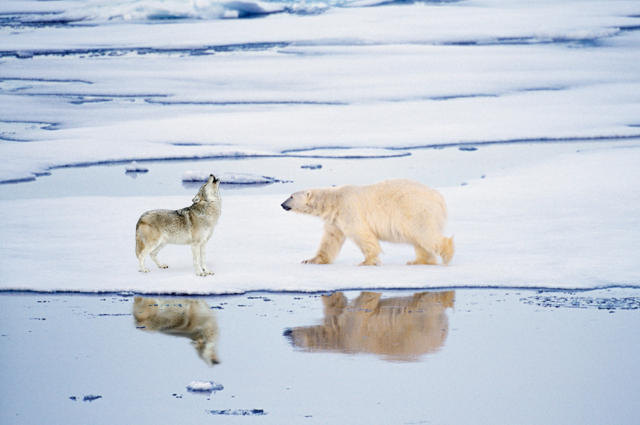 Photo illustration by Tom Twigg / Grist
Photo illustration by Tom Twigg / Grist
Next week brings two milestones in wildlife protection that serve as a lesson in contrasts — examples of what the environmental movement has been and what it’s becoming.
On Monday, gray wolves in Montana, Idaho, and parts of other northern states leave the endangered species list, designated as an officially “recovered” species. Once driven nearly to extinction, the wolves will fall under the watch of state management — which includes hunting — following the Obama Interior Department’s decision in March to sign off on a delisting process put in motion on George W. Bush’s watch.
Later in the week, the legal status of polar bears will become clearer when the Obama administration must decide whether to overturn a last-minute Bush move that denied the arctic mammals key protections under the Endangered Species Act. Acknowledging that the polar bear is threatened by a melting habitat, Bush officials still ruled that endangered species protections cannot apply to causes originating outside of their habitat (in other words, the greenhouse gas emissions heating up the polar regions). Obama has until May 9 to overturn the decision; otherwise, it stands.
Two different species located in very different places — what’s the connection?
The wolf story is a chapter in the environmental movement’s decades-long efforts to protect specific species and eco-systems — a campaign descended directly from “save the whales” and “stop the logging.” Protecting the polar bear, however, is all about confronting the existential threat of global warming.
Wolf, meet bear. When it comes to saving the planet, you’re just a sideshow.
A political decision?
Gray wolves are a classic “old environmentalism” problem. Humans threatened the species in a very localized way: they shot too many wolves and settled in their habitat. Local ecosystems were disrupted, and when the federal government introduced a Rocky Mountain recovery plan in 1995, it tried to balance the interests of local parties, such as cattle and sheep farmers. Environmentalists fought for stronger protections through their long-preferred method — lawsuits. This continues: a coalition led by Earthjustice will sue to overturn the wolf decision in June, once a 60-days-notice requirement has been met.
For years the Bush administration sought to remove wolves from the endangered species list, and wolf advocates twice blocked the move in court. When Interior Secretary Ken Salazar upheld the Bush policy in March (it had been put on hold by the new administration), it was like, well, upholding a Bush environmental policy — exactly the opposite of what many in the environmental community expected.
In public and private statements, Interior officials have framed wolves’ resurgence as a success story — what the Endangered Species Act intended. They cite the wolf population across the Northern Rockies — about 1,600, including about 100 breeding pairs — and evidence that wolf packs in three distinct areas (Yellowstone ecosystem, central Idaho, and northwest Montana) have enough contact to interbreed and ensure genetic diversity.
“The population has really come back from the brink,” said Seth Willey, a Fish and Wildlife Service (FWS) regional recovery coordinator in Denver. “There’s been scientific consensus on this for a long time.”
The delisting hinges on management plans submitted by the states. Montana’s and Idaho’s plans were approved, though the department rejected Wyoming’s trigger-happy plan [PDF] as inadequate, so wolves will remain federally protected in that state.
Wildlife groups find the Montana and Idaho plans nearly as troubling; Idaho, in particular, would allow hunters to reduce the current population to 104 animals, down from a current count of 778. Idaho Gov. Butch Otter (R) famously said he would be first line for a wolf hunting license.
“We’ve made all this progress,” said Noah Greenwald, a conservation biologist at the Center for Biological Diversity. “Instead of continuing with that and ensuring the wolves recover to a larger area of their historic range, we’re going to shut the door and allow them, particularly Idaho, to reduce their population to the point where it’s questionable they’re going to be viable.”
Suzanne Stone, an Idaho field conservationist for Defenders of Wildlife, a leading wolf advocacy group, questioned whether the Rocky Mountain populations are sufficiently connected, as FWS claims. She said federal recovery goals are based on an outdated 1987 plan [PDF].
“Since that time, wildlife scientists have repeatedly warned that the original wolf recovery goals were set too low and in order to reach a recovered metapopulation, the northern Rockies wolf population needs to be much larger than a few hundred wolves,” she wrote in an email. “… Genetic scientists have also confirmed that when our regional wolf population reached 450 wolves region wide (the current requirement for delisting), the wolf population was still disconnected and not functioning as a metapopulation by providing genetic connectivity between all three subpopulations.”
The Interior Department maintains its plans are based on the best available science. The government’s recovery findings were detailed in the Federal Register [PDF] on April 2, written largely by wolf recovery architect Ed Bangs. Further, said spokesperson Hugh Vickery, the Endangered Species Act compels a species to be delisted when it has recovered, meaning Salazar’s decisions was less a judgment call than a requirement.
“How the decision is made is clearly spelled out in the law,” Vickery said. “If the best available science says to do it, we have to do it.”
The department’s handling of the announcement didn’t win it any friends. Wildlife groups that had worked on the issue for years resented being caught off guard by the announcement.
“It’s too soon to pass judgment on how [Salazar] will ultimately do as secretary, but certainly it was a warning flag that more needs to be done to arrive at these decisions carefully, that more communication needs to occur,” said Bob Irvin, the senior vice president for wildlife at Defenders.
Congressional supporters of continued protections also felt left in the dark on announcement. Sen. Barbara Boxer (D-Calif.) wrote to Salazar asking him to delay the effective date (he did not). She also questioned whether the Endangered Species Act allows the department to single out a particular area — Wyoming — for continued protection, a point Defenders of Wildlife also raises.
A staff member for Rep. Norm Dicks (D-Wash.), another longtime wolf advocate, said simply that Dicks found the announcement unexpected, disagreed with it, and had spoken to Salazar about it.
Defenders of Wildlife filed a Freedom of Information Act request for documents showing whether Salazar looked at any new research before making the “scientifically flawed” decision. It’s awaiting a response, Irvin said.
“We’re very disappointed in the [wolf] decision, but it’s way too early to draw any lines between it and future administration actions,” said Andrew Wetzler, endangered species project director for the Natural Resources Defense Council. “This is a bad decision among a number of good decisions.”
Polar bears and the climate fight
Unlike gray wolves, the threat to polar bears’ habitat isn’t local. It won’t be fixed with a regional management plan, which can’t address greenhouse gases from tailpipe emissions in Los Angeles or coal plants in India. It won’t be fixed with a typical lawsuit — wildlife advocates can’t litigate a national (or global) climate change plan into existence.
True, polar bears are furry and loveable (from a distance!), and much like wolves inspire awe at nature’s untamed predators. Like wolves, they require protection from local habitat destruction. But polar bears have become the poster-species for the issue that defines the new environmental movement — one that concerns itself less with charismatic species than with the tremendous disruption to human life that climate change will bring.
On its surface, the wolf delisting puts President Obama in an awkward spot — upsetting a key plank in the Democratic platform — environmental voters — and complicating the clean break he’s tried to make from Bush’s environmental policies. The political sensitivity of the decision was made clear by the fact that Salazar’s announcement back in March came on a Friday afternoon, the classic time for downplaying unpopular news, and was issued with no comment from the White House.
But if the White House upholds the Bush decisions on wolves, it may show that Obama is making a political calculation. The president’s selection of Salazar, a Colorado senator with a fairly strong environmental record and deep family ties to ranching, can be seen as a signal of the president’s belief that it’s more important to mediate culturally charged western states issues like wolves and save political ammunition for the bigger challenge — enacting a comprehensive strategy for combating climate change.
“The science makes it so clear that the polar bear is threatened by greenhouse gas emissions, and it’s such a well-known species, that they should be considering rescinding [the Bush-era rule]. I think it’s still possible they will,” said Greenwald of the Center for Biological Diversity.
Overturning the Bush exception, Greenwald said, could lend additional weight to efforts to strengthen auto-efficiency standards and block offshore drilling and oil shale development.
Interior Department Press Secretary Kendra Barkoff said the department had not yet decided on the polar bear rule. A decision must come by next Saturday.
More Information and How You Can Take Action
- Defenders of Wildlife and Gray Wolves
- Help Defenders of Wildlife protect gray wolves
- Center for Biological Diversity and gray wolves
- Defenders of Wildlife and polar bears
- Center for Biological Diversity and polar bears


